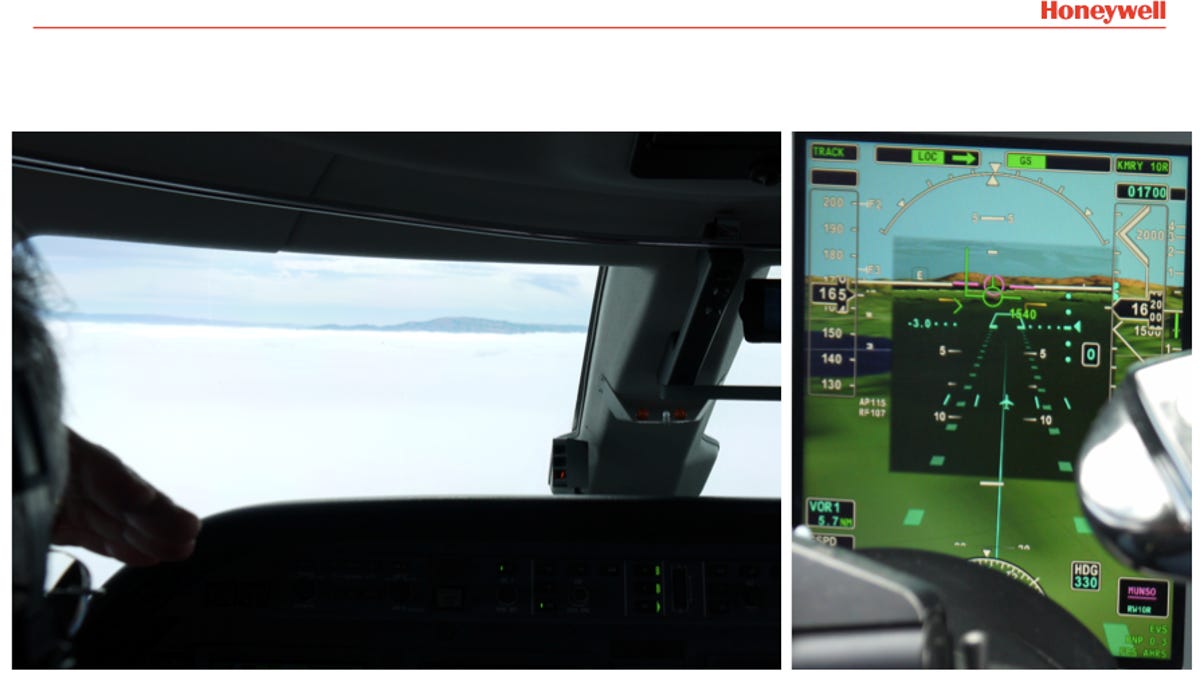New technology could slash airplane delays
Honeywell technology currently under development could make it possible for pilots to land safely even when clouds come down as low as 100 feet off the ground.

If a technology being developed by aerospace giant Honeywell that helps airplanes land in very cloudy conditions wins regulatory approval, it could make a huge dent in weather-related delays throughout the aviation system.
The technology is called Enhanced Visual System/Synthetic Vision System (EVS/SVS), and it is designed to give pilots the information they need to land safely even when there is cloud cover near ground. Current U.S. rules mandate that pilots decide at the 200-foot mark if their ground visibility is good enough to land or if they need to circle around for another try. With EVS/SVS, they would be able to hold off on making that decision until between 100 and 150 feet.
According to Bob Witwer, vice president of advanced technology for Honeywell aerospace, cloud cover below 200 feet was responsible for six entire days' worth of delay at a single airport--New York's La Guardia--in 2010. And as anyone who flies in the United States knows, delays in one city can easily roll over and cause slowdowns or even flight cancellations throughout the country.
For years, Witwer said, airlines have relied on Honeywell's Synthetic Vision System, which provides pilots with a database and 3D graphical representation of their flight paths, complete with detailed imagery showing terrain and obstacles and automatic warnings triggered when their planes get too close. The idea was that the system could offer pilots a better sense of situational awareness, especially when flying into areas where the terrain is "aggressive," such as mountainous destinations like Aspen, Colo.
Related links
• After flight delays, FAA may add backup system
• U.S. flight delays pegged to FAA computer woes
• Can technology solve air travel woes?
All told, Witwer said, airlines have flown 800 million hours using Honeywell's Enhanced Ground Proximity Warning System. But that system can't do anything to help pilots when clouds are too close to the ground. At least not by itself.
However, with Honeywell's new EVS technology, Witwer said, pilots trying to land in cloudy conditions can look at their instrument displays and see a graphical representation of the area that "makes it look like a sunny day."
EVS works, Witwer said, with the aid of an infrared sensor mounted on the nose of an aircraft, which can capture real-time imagery of the ground and blend it with SVS data. Together, the two sets of data can provide a clear view of the ground, he explained, even if, in some cases, clouds go below 100 feet. "Infrared can pick up things with thermal signatures that the eye can't," like runway lights, Witwer said. "Those are the kinds of things that infrared can pick up, even if vision is obscured to the naked eye."
Witwer said that even the 100-foot limitation could disappear over time, but that it is in place in the EVS technology today owing to issues like signal accuracy around airports and general system redundancy. And in any case, Honeywell believes cloud cover lower than 100 feet is a rare situation and that it's often possible to see the runway from that height anyway.
Ultimately, Honeywell is betting that airlines and the aviation industry in general will see the value of the EVS/SVS marriage and that the technology, when and if it is approved by the U.S. Federal Aviation Administration, will help the industry cut down on delayed landings, save fuel, and generally improve the flying experience. So far, Witwer said, pilots have test-flown about 100 hours using the technology, with thousands more hours in engineering tests.
Still, Witwer said it's far too early to know if or when the FAA will approve the technology or how many more hours of testing the agency will require before it considers the system ready for prime time.
Correction (Wednesday, 11:01 p.m. PST): This story has been updated to more accurately reflect how the EVS/SVS system affects pilots' decision point for landing.

